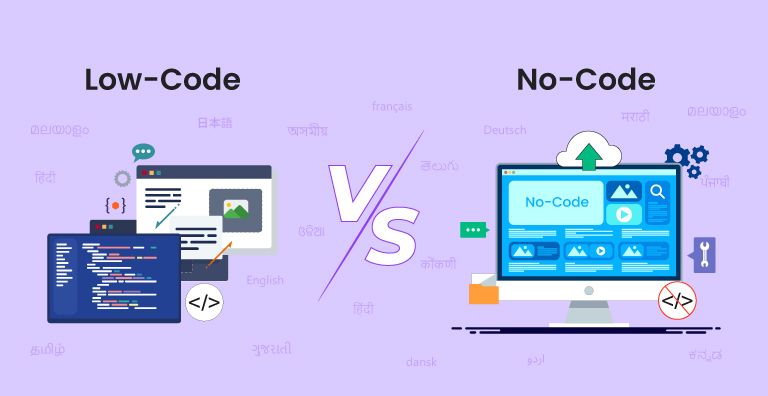Low code and no code are development platforms that simplify it for developers and non-developers to develop applications. Yes, you’ve heard the latter part as well, right. Low code and no code platforms have helped revolutionize multilingual solutions as well. However, what is the difference between low code and no code multilingual solution? Let’s look at some no code vs. low code differences in this blog.
What is Low Code?
Low code is a contemporary application development approach that requires less programming expertise and uses a visual, drag-and-drop interface to build applications. A low-coded platform uses pre-built blocks of coded commands that one can organize and connect via programming into broader workflows. In other words, low code platforms leverage pre-built components and templates to streamline the development process and enable developers to expedite the development of sophisticated applications.
What is No Code?
No code refers to software development that doesn’t require programming expertise. It enables people with little to no coding expertise (citizen developers) to create applications and software without any conventional programming languages. A no code platform enables users to develop custom applications, automate workflows, etc., without writing any code. It is similar to low-code and requires minimal training.
Low Code Vs. No Code – Highlighting Key Differences
Here are some essential differences between low code and no code platforms.
| Parameters | Low Code Platforms | No Code Platforms |
| Target Developer Audience | Low code platforms primarily target professional developers looking to expedite software development. | On the other hand, no code platforms intend to help laypersons, also called citizen developers, with little or no programming knowledge. |
| Coding Knowledge | Users or developers will be required to have coding knowledge for advanced features. | Coding knowledge is not required or minimally required. |
| Integration | Low code multilingual solutions allow integration with external services and APIs. | No-code multilingual solutions offer limited integration options due to built-in features. |
| Scalability | Low-code multilingual solutions are usually more scalable to adapt to the increasing multilingual requirements. | No-code multilingual solutions may confront limitations with an increase in the requirement. |
| Capabilities | Low-code can handle more sophisticated multilingual solutions. | No-code is suited for more straightforward multilingual solutions. |
| Multilingual Features and Functionalities | Low code multilingual solutions have various features for managing multilingual content. | No-code multilingual platforms usually have only basic features. |
| Customization Scope | Low code multilingual platforms offer a higher degree of flexibility and customization options. | No-code multilingual platforms do not have as many customization options as their low code counterparts. |
| Community Support | Low code platforms usually have a broader community support, thus offering more resources for problem-solving and troubleshooting. | The extent of community support may differ based on the solution developed. |
| Extensibility | Low code multilingual platforms offer a higher degree of extensibility via customized codes and integrations. | The extensibility of no code multilingual platforms usually doesn’t go beyond its built-in features. |
| Maintenance Requirements | Requirements Low code platforms require regular maintenance and updates, particularly for the various customizations and integrations they have. | In the case of no code platforms, the maintenance aspect is handled by the service provider. |
| Cost | The cost involves subscription fees and may require the subscriber to pay more for additional customizations and integrations based on their needs. | The cost is subscription-based. However, since customization options are limited, the overall cost may be lower than low code multilingual solutions. |
| Security | Users should take care of the security of the application’s customizations and integrations. | With no code platforms, security remains the provider’s responsibility. |
We hope the above low code no code differences help you make an informed choice. If you still have questions and want a low code no code multilingual solution for your needs, choose LinguaSol! We are one among the leading language solutions providers. Our team of experts, extensive language expertise, experience and technology access speak for our credibility as a language solution provider. Please email us at [email protected] to explore more about our multilingual solutions.
Ref. No- LSB3241041


